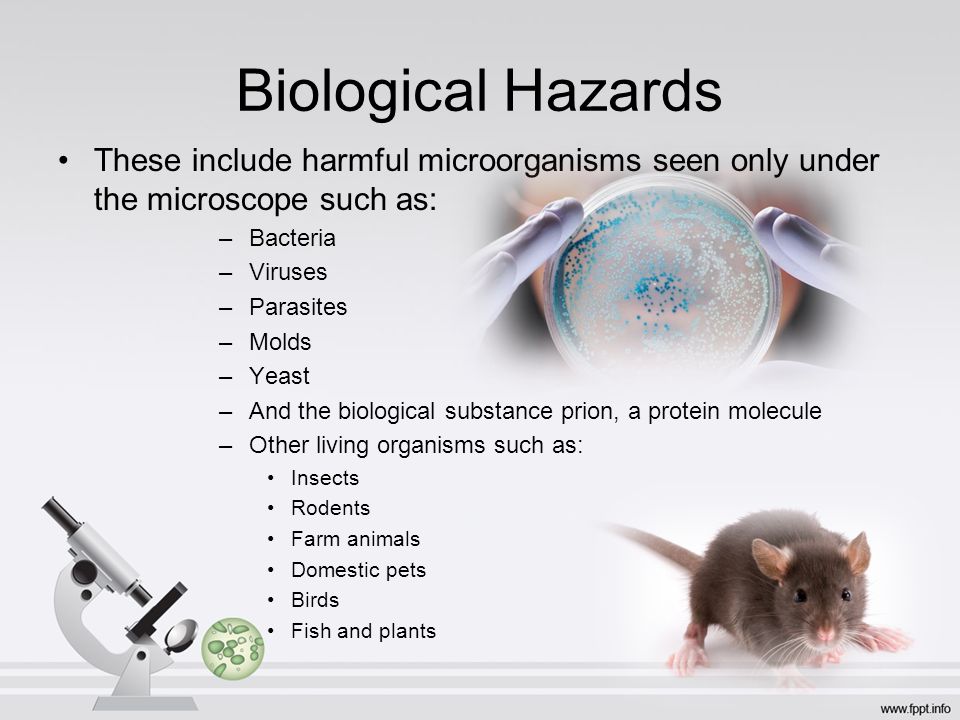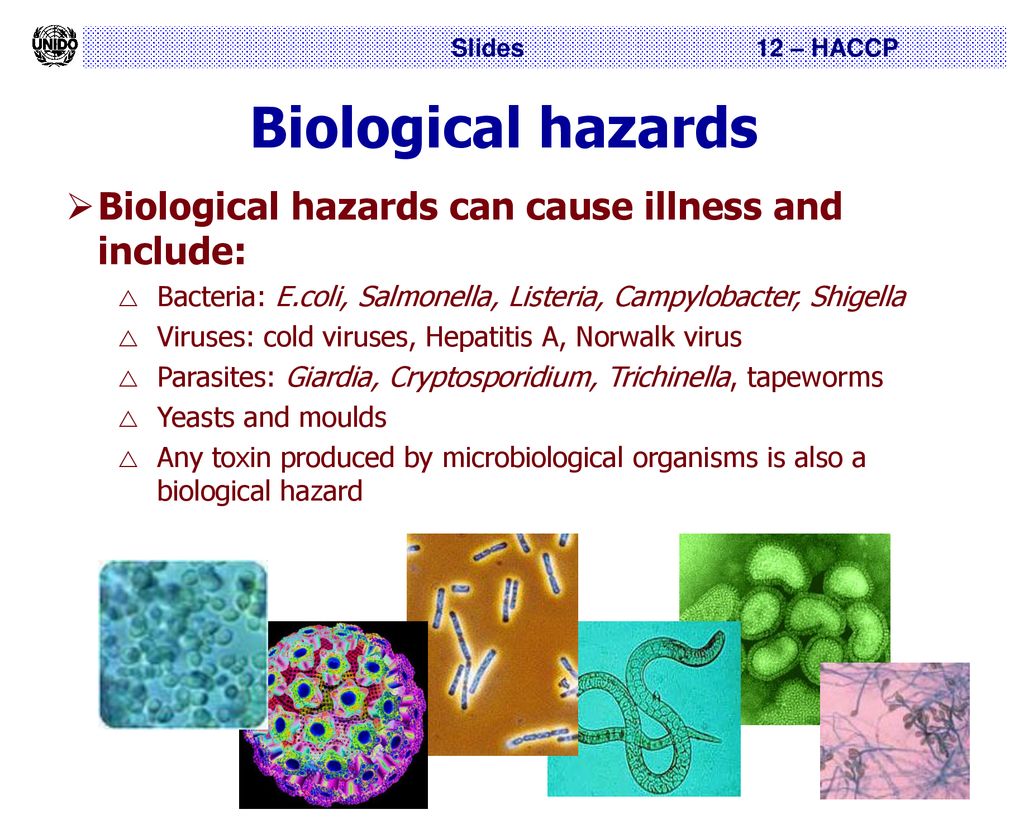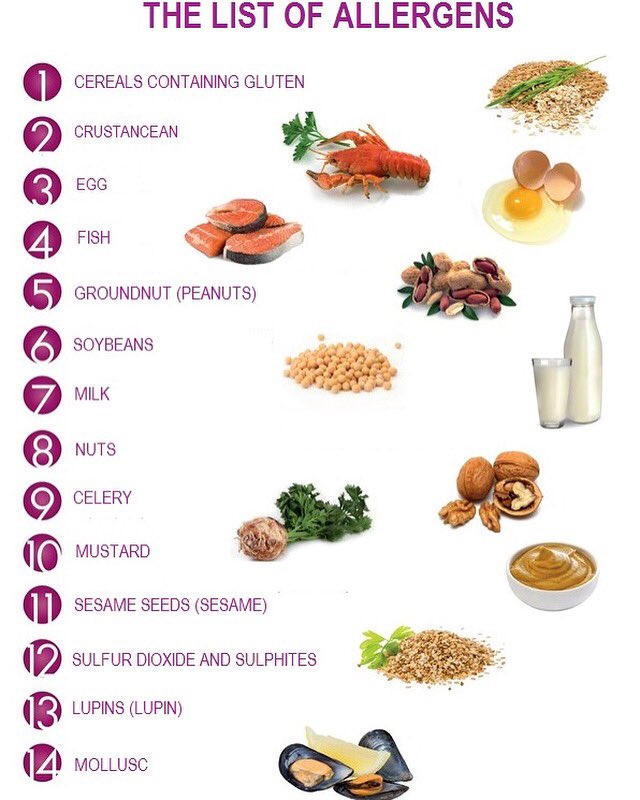Food Hazard & Prevention technique
What is food hazard: –
A food hazard is defined as anything that could contaminate food and cause illness or injury or could otherwise violate established food safety program criteria if left uncontrolled. Food Hazard means dangerous or risky in our health. Most of the time the hazardous product will see in contaminated food like canned goods or even in raw food. To prevent the food hazard, we need to practice the good manufacturing.
Food Safety Hazards
There are four primary categories of food safety hazards to consider: biological, chemical, physical, and allergenic. Understanding the risks associated with each can dramatically reduce the potential of a foodborne illness. Each has their own unique characteristics, but all can be avoided through a robust food safety management system (FSMS).
Biological Hazards
Biological hazards are characterized by the contamination of food by microorganisms. Found in the air, food, water, animals, and in the human body, these incredibly tiny organisms are not inherently unsafe – many provide benefits to our anatomy. Despite this, foodborne illness can occur if harmful microorganisms make their way into the food we eat. There are several types of microorganisms, each of which can negatively impact health: bacteria, viruses, and parasites.






There are a variety of factors that influence dangerous microorganism growth, including temperature, pH levels, and moisture of the food.
The USDA has coined a term for the temperature range that encourages bacterial growth: the Danger Zone. This temperature range, 40° F – 140° F, enables bacteria to grow most rapidly, nearly doubling its number in 20 minutes. In addition, the pH level of a food, or its acidity, can accelerate growth. Foods that are less acidic, such as milk, tend to foster bacteria at higher rates than more acidic foods, like lemon juice. Microbes prefer warmer, wetter environments, which make moist foods hotbeds for microorganism growth.
Biological Hazard Examples
| Biological Hazard | Commonly found in |
| Salmonella | Eggs, poultry, meat, unpasteurized milk or juice, cheese, fruits and vegetables, spices, and nuts |
| Norovirus | Produce, shellfish, ready-to-eat foods |
| Campylobacter | Raw and undercooked poultry, unpasteurized milk, contaminated water |
| E. coli | Undercooked ground beef, unpasteurized milk or juice, raw milk cheeses, raw fruits and vegetables, contaminated water |
| Listeria | Ready-to-eat deli meats and hot dogs, unpasteurized milk or juice, raw milk cheeses |
| Clostridium perfringens | Beef, poultry, gravies |
Biological Hazard Prevention
The best way to prevent biological hazards from affecting customers is to implement robust processing and storage strategies. Kill steps used prior to packaging is necessary, such as cooking thoroughly or pasteurization of milk and juices. Use of packaging technologies during processing like vacuum sealing hinders bacterial growth. Proper temperature management for storage can dramatically reduce microbe growth. Finally, effective sanitation practices throughout the distribution chain will reduce cross-contamination of food products.
Chemical Hazards
Chemical hazards are identified by the presence of harmful substances that can be found in food naturally, or unintentionally added during processing. Some chemical hazards include naturally occurring chemicals, such as mycotoxins, intentionally added chemicals, including the preservative sodium nitrate, and unintentionally added chemicals, like pesticides.

Chemical Hazards Examples
| Chemical Hazard | Examples |
| Mycotoxins | Produced by fungi and can be toxic to humans and animals. They are formed by moulds which grow on crops and foods under certain conditions. |
| Natural Toxins | Biochemical compounds produced by plants in response to certain conditions or stressors. |
| Marine Toxins | Decomposition or microscopic marine algae accumulated in fish and shellfish. |
| Environmental Contaminants | Accidentally or deliberately enter the environment. Typically manufactured for industrial use. |
| Food Additives | Any chemical substance that is added to food during preparation or storage. |
| Processing-induced Chemicals | Undesirable chemicals can be formed in certain foods during processing as a result of reactions between compounds that are natural components of the food. |
| Pesticides/Agricultural Products | Used to control, destroy, or repel a pest, or to mitigate the effects of a pest. |
| Veterinary Drug Residues | Used in food-producing animals to control and/or prevent illness in the animal. |
Chemical Hazards Prevention
Similar to preventing biological hazards, proper cleaning procedures and sanitation requirements are the best methods of prevention. Training employees to follow strict guidelines is essential in preventing a chemical hazard. Additionally, limiting the use of chemicals to those generally recognized as safe (GRAS), and ensuring that chemicals are stored in designated areas separated from food products.
- Physical Hazards
Physical hazards are foreign objects that are found in food products. They are either naturally found in the specific item, such as stems in fruit, or not normally part of the food item, such as hair or plastic. Unnatural physical hazards are generally more dangerous to health, whereas natural physical hazards can be harmless.
Physical Hazards Examples
| Physical Hazard | Examples |
| Unnatural | Insects, hair, metal fragments, pieces of plastic, wood chips, and glass |
| Natural | Stems in blueberries, microscopic airborne debris, dirt on potatoes, or minute insect fragments in figs |
Physical Hazards Prevention
Prevention of physical hazards focus primarily on thorough inspection of food, and strict adherence to food safety regulations, such as Hazard Analysis Critical Control Point (HACCP) discussed below. Organizations can also take proactive steps in eliminating the potential of a physical hazard. Light bulbs, for instance, can be manufactured using different materials. Acrylic is both lighter and stronger than glass, and tends to shatter into larger, blunter fragments than glass.
- Allergenic Hazards
The final, and perhaps the most deadly, are allergenic hazards. Allergies are the 6th leading cause of chronic illness in the U.S., with more than 50 million people suffering from allergies each year. Allergic reactions occur when the human body produces an abnormal immune response to specific proteins found in food.

Allergenic Hazards
| Allergenic Hazard | Commonly found in |
| Milk | Butter, cheese, cream, milk powders, and yogurt |
| Eggs | Cakes, some meat products, mayonnaise, mousse, pasta, quiche, sauces, and foods brushed with egg |
| Nuts | Breads, biscuits, crackers, desserts, ice cream, marzipan, nut oils, sauces, and curries or stir fries |
| Soy | Desserts, ice cream, sauces, and vegetarian products |
| Wheat | Baking powders, batter, breadcrumbs, brea, cakes, couscous, pasta, pastries, sauces, soups, and foods dusted with flour |
| Fish | Fish sauces, pizzas, relishes, salad dressings, stock cubes, and Worcestershire sauce |
| Shellfish | Shrimp paste, and curries or salads |
Food allergic Prevention
Unfortunately, there is no way to prevent allergies, but it is possible to reduce the risk of an allergic reaction. So long as companies embrace proper sanitation techniques and present potential allergenic ingredients obviously on product packaging, allergic reactions will be minimized. Preventing an allergic reaction falls primarily on the consumer, but they can only do so effectively if businesses do their part with effective sanitation and labeling of ingredients.
What Are Food Safety Risk
A risk assessment of a food or ingredient includes hazard identification and characterization, exposure assessment and risk characterization. This leads up to a decision on whether any legal measures should be taken in order to prevent harm by this food or ingredient.
What is the difference between risk assessors and risk managers?
In the safety evaluation of food there is a distinction between risk assessors and risk managers. Risk assessors are organizations that evaluate the potential harmfulness of a food or ingredient. In short, risk assessors review the available scientific data on the safety of a specific food or ingredient and provide information or recommendations to the risk managers. The risk managers finally decide whether any legal measures should be put in place (e.g. approving or restricting certain ingredients from the market).1
What is the difference between hazard and risk?
The World Health Organization (WHO) recommends that in order to conduct a thorough risk assessment, both hazards and risks should be examined.3 Hazard and risk are terms that are often incorrectly used interchangeably, but they are in fact not the same. A hazard is something that has the potential to cause you harm, like lightning. A risk is the likelihood of this hazard causing harm and depends on your situation. For example, if you are indoors during a storm, the risk of being struck is low. If you are outdoors, the risk is greater.4 In other words – the lower the exposure (in dose and duration) to a hazard, the lower the risk.
The 4 steps of a risk assessment
During a risk assessment there are a few steps to be taken in order to evaluate the hazards and risks connected to a food or ingredient.4,5
Step 1 – Hazard identification: “Could this food or anything in it be harmful?”
Risk assessors collect and review scientific data and identify biological or chemical hazards in food.
Step 2 – Hazard characterization: “What effects do the hazards cause?”
The risk assessors evaluate scientific data to determine whether evidence is strong enough to demonstrate that a substance has the potential to cause harm.6 They study the nature of these health effects and, where possible, calculate a safe level of exposure.
Step 3 – Exposure assessment: “Who may be harmed and at what level may exposure be harmful?” Experts estimate how much of the food or ingredient consumers in general, population groups (e.g. infants, children, adults) or sub-populations (e.g. vegetarians, vegans) are likely to be exposed to under real-life conditions, where both dose and duration are considered. The exposure must be evaluated to determine if a hazard presents an actual risk (step 4). With increased exposure, the risk also increases.
Step 4 – Risk characterization: “How likely is it that people will experience exposure at a level that can cause harm in real life?”
The final step is to formulate a final conclusion on the level of risk. The previous steps are taken into account to calculate the likelihood of the food or ingredient causing harm according to the nature of the hazard and level of exposure. The level of exposure that can cause harm is compared to the actual level of exposure that someone would experience in real life. If the exposure level is higher than that which causes harm, there may be a safety concern for consumers in general or for specific groups.
What Are Food Safety Risk Assessments and Why Are They Used?
A risk assessment evaluates if a food is safe to eat. Hazards and risks are evaluated by experts, but the complex assessments are sometimes misunderstood.
How to communicate food risk?
Food risk communication is the process of informing audiences, frequently the general public, about food-related risk and safety issues, and providing enough information to allow them to take action to reduce or avoid risks. As consumers, we receive a lot of information about the food we eat. Every day, we are bombarded with both accurate and misleading information about the benefits or risks (or sometimes both!) of certain foods. Conflicting and inaccurate messages about nutrition science and food safety can decrease public confidence in the food supply. Communicating effectively is crucial to increasing trust and empowering people to make informed decisions about healthy diets and lifestyles.
****

